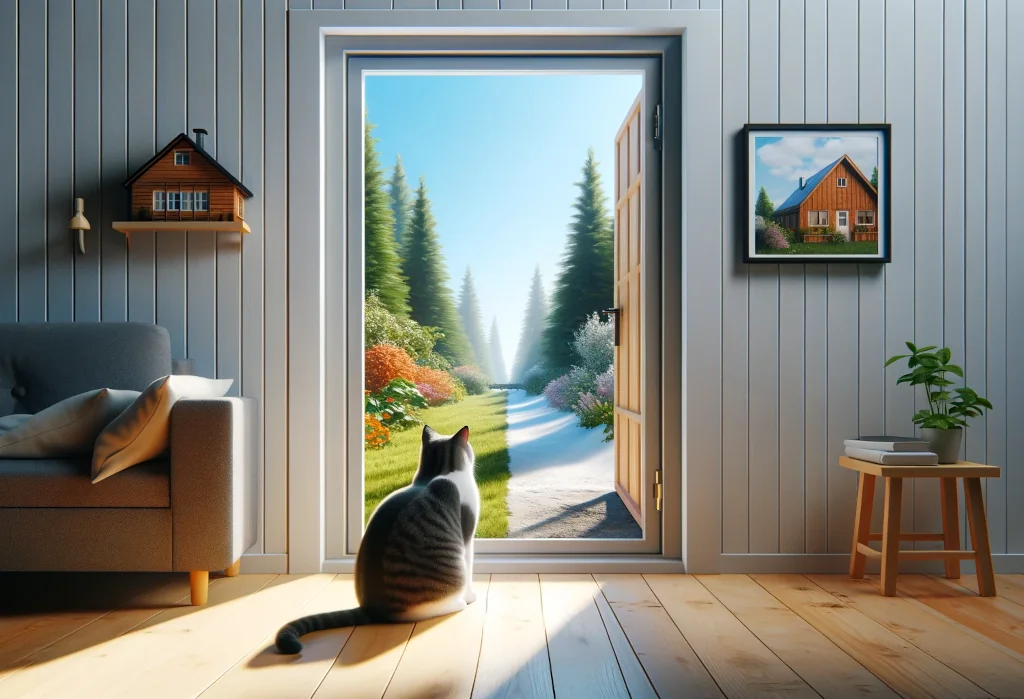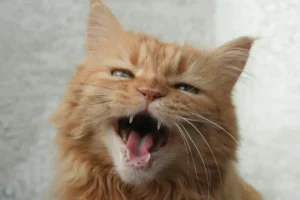
Have you ever watched, perplexed, as your furball scratches at the door, their eyes wide with the desire to explore the world beyond? It’s a scenario most cat owners know all too well – the persistent meowing, the longing stares out the window, the bold dashes to the door whenever it opens. It’s enough to make you wonder what’s so enchanting about the great outdoors that makes your indoor kitty so desperate to venture out.
Understanding this feline wanderlust can be tricky, but you’re not alone in your curiosity. This blog dives deep into the heart of why your cat seems to have such an intense desire to be outside.
Quick Takeaways:
- Cats’ natural hunting and territorial instincts drive their desire to explore outdoors.
- Enriching your cat’s indoor environment with vertical spaces, interactive play, and window perches can satisfy their curiosity safely.
- Alternatives like leashed walks, catios, and indoor gardens offer safe ways for cats to experience the outdoors.
Is It All About Instinct?
Ever noticed your feline friend making a beeline for the door every time it opens? It’s not just mere curiosity. Cats are driven by a cocktail of instincts that whisper to them, urging them to explore beyond the four walls they call home.
At the heart of this desire is their innate hunting instinct. Though your kitty may live a life of luxury, feasting on gourmet cat food, their primal urge to hunt can’t be satisfied with a bowl of kibble. This instinct is matched by their territorial nature. Outdoors represents an unclaimed kingdom waiting to be explored and marked. Between the thrill of the hunt and the call of the wild, it’s no wonder that the great outdoors seems so enticing to our furry companions.
What Are the Signs Your Cat Wants to Go Outside?
Identifying the signs of a cat yearning for adventure can save you from the heartache of a door-dashing escape artist. Here are a few behaviors to watch out for:
- Door-Dashing: If your cat camps out by the door, ready to slip through at the first opportunity, it’s a clear sign they’re itching to explore.
- Window-Gazing: Spending hours staring longingly out the window, often accompanied by chirping or meowing, is your cat’s way of dreaming about the great outdoors.
- Restlessness: If your cat seems unusually antsy or is displaying zoomies more frequently, it could be an indication they’re craving more space and stimulation.
Why Do These Signs Matter?
Recognizing these behaviors is the first step in understanding your cat’s needs. It opens up a dialogue between you and your pet and helps you find ways to satisfy their desires safely.
Can Indoor Life Be Fulfilling for a Cat?
Absolutely! While the allure of the outside world is strong, you can create a stimulating indoor environment that meets your cat’s needs. Here are strategies to ensure your indoor cat remains content, healthy, and stimulated:
- Create a Vertical Space: Cats love to climb and view their domain from a height. Investing in cat trees or installing wall shelves can provide the perfect perch for your feline friend.
- Bring the Outdoors In: Plant cat grass or install a cat-safe herb garden. These can provide a taste of the outside world and are great for nibbling.
- Interactive Play: Dedicate time each day to play with your cat using interactive toys that mimic prey, such as laser pointers or feather wands.
- Puzzle Feeders and Toys: These can stimulate your cat’s brain and satisfy their hunting instinct, turning mealtime into an engaging activity.
Unique Tip : Window Perches – Install a secure window seat for your cat. This allows them to observe the world safely from indoors. Go a step further and set up a bird feeder outside the window they frequent. It’s like CatTV, providing hours of entertainment.
By embracing these strategies, you can keep your cat happy and healthy without needing to venture outside. Remember, the goal is to simulate the stimulating aspects of the outdoors within the safety of your home. Your cat doesn’t need to roam the neighborhood to fulfill their wildest dreams. With a little creativity, you can turn your home into a cat’s paradise.
How Safe Is Outdoor Living for Cats?
Cats are natural explorers, and the great outdoors presents a world of adventures for them. However, alongside these adventures come risks. From traffic accidents to potential conflicts with other animals and exposure to illnesses, outdoor living is not without its dangers. But, it’s also filled with benefits like exercise, mental stimulation, and the joy of basking in the sun.
It’s a mixed bag, to be honest. A study from the Journal of Veterinary Behavior shows that outdoor cats are more prone to infectious diseases and have a higher risk of injury, but also suggests they exhibit fewer behavioral problems linked to confinement.
Safety Measures are crucial if you decide to let your cat out. Vaccinations, regular health check-ups, and a microchip can tilt the balance towards a safer outdoor experience.
What Alternatives Can You Offer Your Cat?
Not keen on letting your furry friend roam freely? No worries, there’s a whole spectrum of alternatives.
- Leashed Walks: Yes, cats can be walked on a leash, much like dogs. It’s a safe way to explore the outdoors together. Start with a harness that fits comfortably, and gradually acclimate your cat to the leash and the great outdoors.
- Catio: A catio, or a cat patio, is essentially an outdoor enclosure that allows your cat to enjoy the fresh air and sunshine while staying safe. From simple window box designs to elaborate garden enclosures, there’s a catio to fit every space and budget.
- Indoor Gardens: Create an indoor herb garden with cat-safe plants like catnip or cat grass. It’s a unique alternative that most bloggers don’t talk about. This little slice of nature inside your home can provide your cat with the sensory stimulation of the great outdoors.
How to Transition an Outdoor Cat to an Indoor Lifestyle
Making the indoor life appealing to a cat used to the freedoms of outdoor living might seem challenging, but it’s definitely doable with patience and creativity.
- Enrich the Indoor Environment: Think vertically—cats love to climb and observe their domain from high vantage points. Shelves, cat trees, and window perches can transform your living space into a cat’s paradise.
- Engage Their Hunter Instinct: Interactive toys, puzzle feeders, and games that mimic the hunt provide mental stimulation and physical exercise. Consider a laser pointer session or a toy mouse hunt.
- Establish Routine: Cats are creatures of habit. Establishing a consistent routine for playtime, meals, and cuddles can make indoor life more predictable and satisfying for your cat.
Leafy Escapes : One particularly unique tip is to dedicate a small corner of your home to a ‘leafy escape’—a mini indoor jungle made of cat-friendly plants. Not only does this provide a stimulating environment for your cat, but it also adds a touch of nature to your home.
Transitioning your cat from outdoor adventures to an enriching indoor lifestyle can be a rewarding journey. It’s all about tapping into their natural behaviors and offering them appealing alternatives to the wide world outside. With patience and creativity, your cat can enjoy a fulfilling life indoors, leaving you with peace of mind about their safety and well-being. Remember, the key is to make the indoors just as interesting as the outdoors, and with these tips, you’re well on your way to achieving that.
Alex, a passionate animal lover, has experience in training and understanding animal behavior. As a proud pet parent to two dogs and three cats, he founded AnimalReport.net to share insights from animal experts and expand his knowledge of the animal kingdom.









